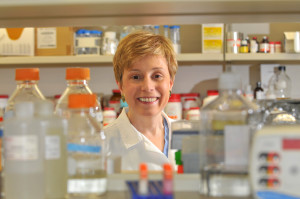 In this guest post, Dr Susan Clare of Northwestern University’s Feinberg School of Medicine, and co-author of a recent paper published in Breast Cancer Research, writes about the importance of research on the ‘normal’ breast and what’s needed to allow this research to take place.
In this guest post, Dr Susan Clare of Northwestern University’s Feinberg School of Medicine, and co-author of a recent paper published in Breast Cancer Research, writes about the importance of research on the ‘normal’ breast and what’s needed to allow this research to take place.
Our limited understanding of the developmental biology and genetics of normal breast tissue is a barrier to progress in understanding the causes of breast cancer and to developing successful prevention strategies and improved treatments. This oft repeated refrain is found in the periodic reviews of the state of breast cancer research and dates back at least to the NCI’s Report of the Breast Cancer Progress Review Group (1997).
Tissues banks and other initiatives mean there is no longer a ‘bottleneck’
The establishment of The Susan G. Komen for the Cure Tissue Bank at the IU Simon Cancer Center (KTB) places researchers worldwide in a position to address this refrain. Researchers now have access to an abundance of high quality, richly annotated normal breast tissue – a gift from healthy volunteer donors to breast cancer researchers, and ultimately to patients.
Another resource for ‘normal’ is the Dr. Susan Love Research Foundation’s Army of Women. Rather than banking specimens, the Army of Women uses email blasts to match registered volunteers interested in participating in breast cancer research with specific projects. Lack of access to normal tissue and/or healthy women and men is no longer a bottleneck to research on the normal breast. What is required to move forward is innovative ways of thinking in order to optimally utilize these resources, and funding agencies willing to support this work.
Our recently published RNA analysis of the breast duct cells of 20 premenopausal donors to the KTB as a function of the menstrual cycle is a start. It offers confirmation in human specimens of data developed in mouse models, and provides molecular insight into epidemiologic observations made over two decades ago. It also represents the beginning of a reference data set of the normal mammary gland.
Ensuring the quality of samples is a continual challenge
The quality of the data produced from any study utilizing tissue is absolutely reliant on the quality of the specimen. For many researchers the life history of a specimen prior to its arrival in the laboratory is unknown or unspecified. Tissue/specimen banking, if done well, is labor intensive and therefore costly. Too often tissue is wrapped in aluminum foil, its identity marked with a Sharpie, and then tossed into the -80°C freezer. In other circumstances, the tissue remains warm and ischemic in a bucket in the operating room for an indeterminate amount of time until it is delivered to a tissue pathology lab for processing.
This should be of critical concern to an investigator because the ways in which the specimen was obtained, processed and stored may have introduced bias into the specimen. The danger of unknown bias hardwired into a specimen is that it may produce a ‘signal’ in the data that is interpreted as supporting or refuting an hypothesis, when in fact it represents suboptimal specimen handling.
We need to make sure that best practice is adhered to
All of us utilizing tissue specimens owe a debt of gratitude to the organizations which have sought to develop and promulgate best practices in specimen acquisition, processing and storage. Among these organizations are the National Cancer Institute’s (NCI) Biorepositories and Biospecimen Research Branch (BBRB), The International Society for Biological and Environmental Repositories (ISBER), and the College of American Pathologists’ Accreditation for Biorepositories. Examples of best practice guidelines can be found for the BBRB here, ISBER here, and the Organization for Economic Co-operation and Development here. Researchers should be aware of these best practices and ensure that the specimens they are utilizing meet the specifications outlined.
The collection of all specimens by the Komen Tissue Bank is governed by standard operating procedures (SOPs), which were developed by referring to the published best practice guidelines. The purpose of SOPs is to minimize the introduction of bias into the specimens and to identify it when it cannot be eliminated. The KTB has annotated its specimens with the ‘Standard PREanalytical Code’ (SPREC), which codes pre-analytic variables and provides detailed information to the end user.

The contribution of donors must not go unrecognised
Thousands of women have donated healthy breast tissue to the Komen Tissue Bank and hundreds volunteer at its collections events. Many of the donors have indicated that the act of donation is a deeply meaningful experience. Healthy members of our communities are willing, and many are eager, to participate in research. We need to partner with them and our Institutional Review Boards to make their participation possible.
The obvious benefit of their participation to a researcher is evident when their medical history, family history or the molecular information within a tissue or blood specimen facilitates the completion of a research project.
Less obvious but equally important, their participation invests them in the project and in the research mission of the hospital and/or academic institution hosting the project. One can never have a more ardent champion or enthusiastic advocate than one who has entrusted you with a part of themselves. It affords the opportunity teach our friends and neighbors about the ‘Scientific Method’; and to share with them, through newsletters and social media, the results of the many research endeavors.
- Microbial forensics: It’s not just fingerprints that can be left behind - 12th May 2015
- How can ‘conservation genomics’ help the recovery of the most endangered species? - 12th December 2014
- Acetate helps hypoxic cancer cells get fat - 11th December 2014
Comments